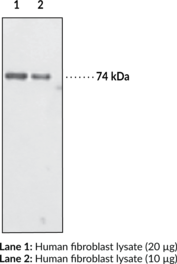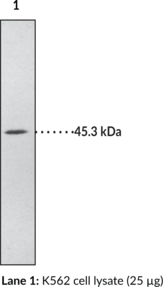Description
Histone deacetylase (HDAC) and histone acetyltransferase (HAT) are enzymes that regulate transcription by selectively deacetylating or acetylating the ε-amino groups of lysines located near the amino termini of core histone proteins.{17241} Eleven members of HDAC family have been identified in the past several years.{17242,17240} These HDAC family members are divided into two classes, I and II. HDAC3 is a Class I HDAC which is related to the yeast HDAC Rpd3.{14468} It is primarily localized to the nucleus with ubiquitous distribution throughout human cell lines and tissues. By modifying chromatin structure and other non-histone proteins, HDACs play important roles in controlling complex biological events, including cell development, differentiation, programmed cell death, angiogenesis, and inflammation. Considering these major roles, it is conceivable that dysregulation of HDACs and subsequent imbalance of acetylation and deacetylation may be involved in the pathogenesis of various diseases, including cancer and inflammatory diseases.{14468}
Synonyms: Histone Deacetylase 3
Immunogen: synthetic peptide corresponding to amino acids 2-17 of human HDAC3
Formulation: 100 µg of protein G-purified IgG in 200 µl PBS containing 0.02% sodium azide
Isotype:
Applications: WB, IP, and ChIP
Origin: Animal/Rabbit
Stability: 365 days
Application|Immunoprecipitation||Application|Western Blot||Product Type|Antibodies|Polyclonal Antibodies||Research Area|Epigenetics, Transcription, & Translation|Erasers|Histone Deacetylation



